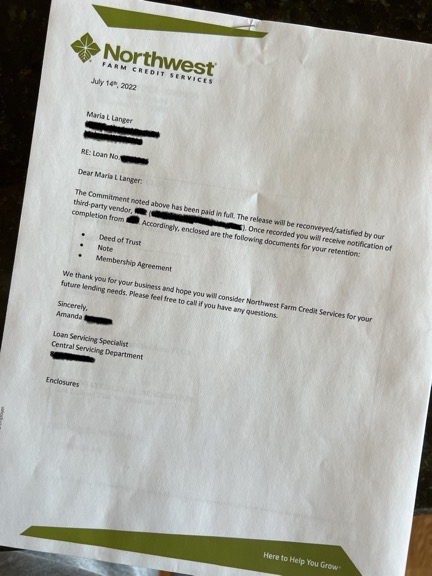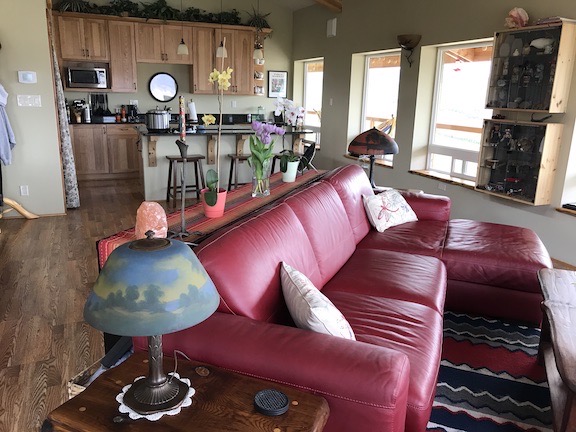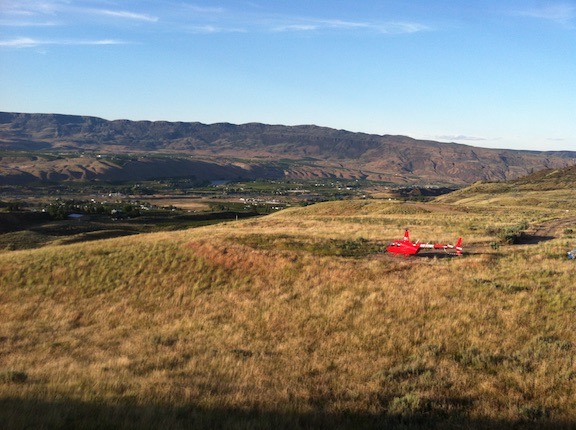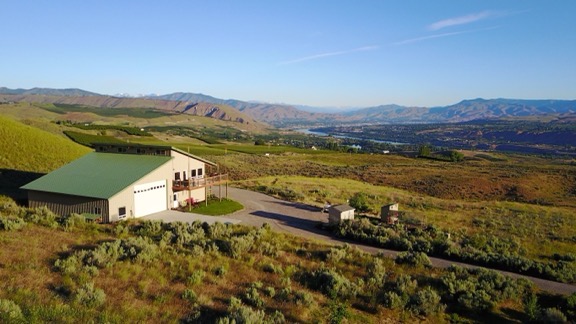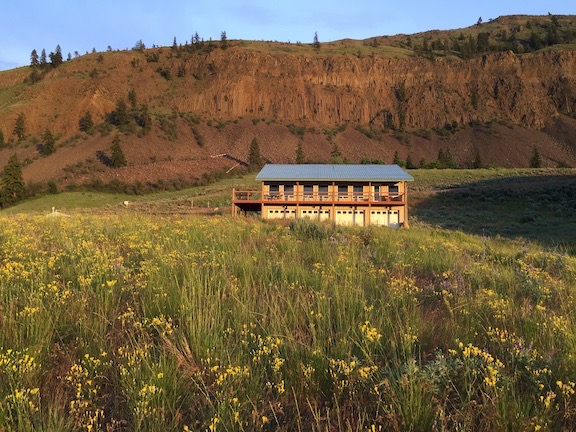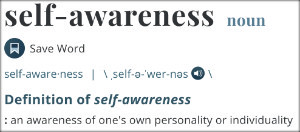Report from my first two months as a trawler owner.
When I write it, you’ll find it in My Great Loop Adventure blog. It’ll have more pictures and, with luck, links to videos on YouTube. Be patient, however; I really do need to get stuff around the house done before I can dive into that. If you haven’t subscribed to that blog, please do. There’s no spam — just immediate notifications of new posts there.
If you’ve been following this blog and/or My Great Loop Adventure blog, you probably know that after exploring the idea of small boat cruising, going on three separate trips ranging from 12 days to 5 weeks each, and researching the kind of boat I might want to cruise in, I bought a 2019 Ranger Tug R-29 CB. I took delivery of the boat right after Labor Day weekend and have spent a total of about 40 days on board since then. The longest stay on board ended yesterday morning: 23 consecutive days traveling from Chicago to Alton, IL (near St. Louis).
I thought I’d share a few of my thoughts about my experiences so far.
It’s Like RVing — on the Water
I have years of experience traveling with various types of RVs. Cruising in my own boat is almost identical to RVing in something like a motorhome or my truck camper. You drive what you sleep in and everything you need/want with you has to fit on board.
To get from place to place, you follow navigable waterways (roads). I’m fortunate in that my boat needs only 2 1/2 feet of water to float in and can fit under bridges as low as 14 feet above the water. (This is almost like traveling in my truck camper, which has high clearance and 4WD to get me into places other rigs can’t go.) There are plenty of printed and electronic resources for finding routes and destinations. My boat has three onboard chart plotters. They’re a lot like using Google Maps on my phone to navigate on the road — they can route me anywhere it’s possible to go. (Unlike Google Maps, however, I can actually turn over control of the boat to the chart plotters and their autopilot system and let them do the driving.)
At the end of a travel day, you can either stop at a marina (campground), stay at a free public wall (truck stop), or anchor out (dry camp). You can stay as long as you want — depending, of course, on whether you need provisions. You buy provisions along the way, taking on fuel and water and groceries when you can. You need to pump-out (dump) your waste tank. Plugging in to shore power (campground power) powers your boat’s systems and charges your onboard batteries; when you’re not plugged in, you’re powering everything off the onboard batteries. (My boat has a total of 6 AGM batteries: 4 house batteries, 1 engine battery, and 1 thruster battery.) A solar panel or generator can provide power or help recharge batteries when you’re not plugged in. (My boat has 160 watts of solar on the roof and I’ve brought along my old Honda 2KW generator in case I need it.) Of course, the batteries are all charged automatically when the engine is running. All this is pretty much the same as with an RV.
There are some notable differences:
- You do not connect to a fresh water source at a marina. Instead, you manually fill a tank and a DC-powered pump handles pressurization at the sinks/showers.
- You have only one waste tank, which is equivalent to an RV’s blackwater tank. It needs to be pumped out with a suction hose — unless you’re a certain number of miles off shore (in the ocean) where you can pump it out in the water. (I won’t ever be that far off shore.)
- There is no gray water tank. Water from the sinks and showers goes right into whatever body of water you’re floating in.
- The water to flush your toilet comes from the body of water you’re in — not from your fresh water supply. Fresh water is used exclusively for the sinks and showers.
- The water heater does not work with propane. Instead, it’s either heated by the engine while you’re under way or heated with an electric water heater when you’re plugged into shore power.
- The refrigerator does not work with propane either. Instead, it works off DC power and is the largest consumer of power when you’re not plugged in. (I find this maddening.)
Fuel Costs
My biggest expense is fuel, which certainly does explain why so many people buy boats like this and don’t take them anywhere. The boat takes diesel and has a 145-gallon tank. I’ll let you do the math on my most recent top-off of about 105 gallons at $5.99/gallon. Ouch.
Of course, fuel consumption is somewhat controllable by moderating my speed. Yes, at full throttle the boat can go 20 knots. It also burns an absurd amount of fuel at that speed. Volvo — the maker of the Penta D4 300 engine — recommends operating at 80% to 90% RPM and that does reduce both speed and fuel consumption, but not enough to make long trips between fuel stops possible. What I’ve discovered is that a cruise speed of about 8 knots is a good compromise between fuel consumption and speed. I can go slower to conserve more fuel but I can also speed up if I need to get somewhere in a hurry. How do I know this? Well, the boat’s engine and chartplotter work together to provide actual speed and fuel consumption data as I cruise.
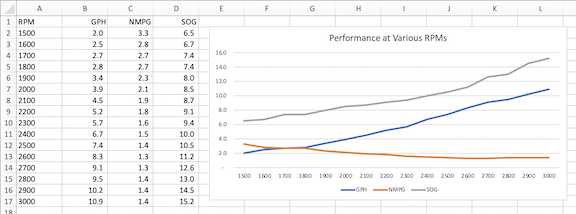
Why, of course I took readings of actual data and plugged them into an Excel spreadsheet so I could chart them. Note that these NMPG and SOG numbers might be a tad high given that we were in the Mississippi River when I noted them and current may have given us a small boost.
So if you’re wondering how far I can get on 145 gallons of diesel, I’m figuring about 300 miles — if I watch my speed. Yes, I can go farther if I go slower but there are only so many hours in a day and I have no plans to cruise at night.
Overnight Accommodations
My other major cost is marinas. I’ve found places to dock ranging in price from free to about $90/night. You generally get what you pay for, although location does play a role.
My most expensive marina stops have been at Roche Harbor (a vacation destination) and downtown Chicago (a major metropolitan area). Both had all facilities I’ve come to expect: 30 amp power, water, pump-out service, restrooms, showers, and restaurants/groceries within walking distance. (More on all those in a moment.)
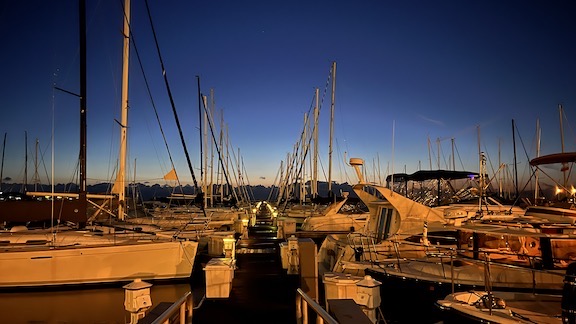
I only took one decent photo while at DuSable Marina in Chicago — and that was early one morning. We were there from October 13 through 15 and the marina was still quite full. But on October 31 (when we were about 300 miles south), it was completely empty because it closes for the winter.
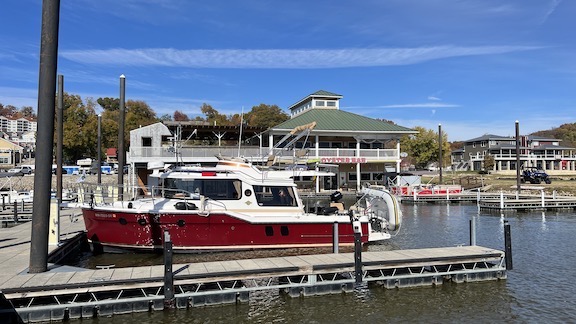
Grafton Harbor was one of my favorite stops. A great restaurant, restrooms, showers, and laundry were all walking distance and we were able to top off water and fuel and get a pump out before leaving.
On the free end of the scale, we parked at the Jolliet, IL City Wall with 30 amp power, the Peoria City Dock with no power in one spot and just 110 v (household current) power in another, and at Mel’s Illinois River Restaurant, with no power. While Peoria had restaurants and a great bakery within walking distance, it’s also the stop where someone stole my portable BBQ grill right off the back deck of the boat one night. (I was lucky they didn’t take the inflatable life jackets or my electric bike, all of which were also on that back deck and a lot more valuable.)
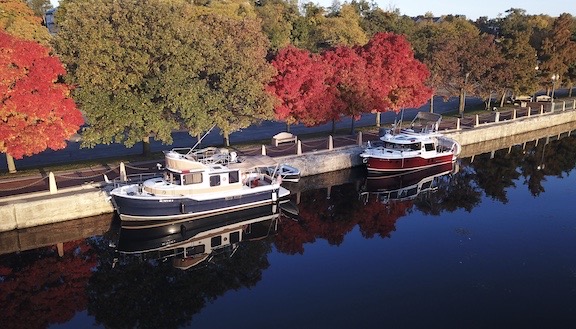
Buddy boats R-31 CB “Pony” and R-29 CB “Do It Now” at the free wall in Jolliet, IL. This was a very nice free stop, especially because of the 30 amp power, autumn foliage, and park for dog walking, but there wasn’t much within walking distance.
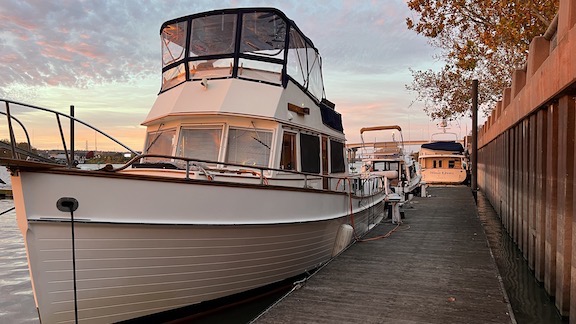
Here are “La Principessa,” “Do It Now,” and “Nine Lives” at Peoria free City Dock. The facility was designed for boats even smaller than mine so the larger boats were left to tie up on a long floating dock that could barely fit two of us. “Nine Lives” is actually parked against the wall beyond the dock and tied up to the top of it; the only way they could get on and off the boat was to climb to their command bridge and over the rail at the top of the wall.
Of course, you can save a ton of money by simply anchoring out overnight. There are plenty of anchorages along the way and and resources like Waterway Guide to tell you what to expect at most of them. The boat is completely self-contained so I don’t need to come on land if I have water on board and space in my toilet waste tank. Of course, with two small dogs on board, dealing with their waste removal needs can be a challenge if I can’t just step off the boat with them for a walk. We anchored out just one night and our spot was wonderfully protected, quiet, and dark. Unfortunately, one of my pups refused to use the special “peepee mat” I’d bought and would up holding it all in for at least 40 hours. More training is required.
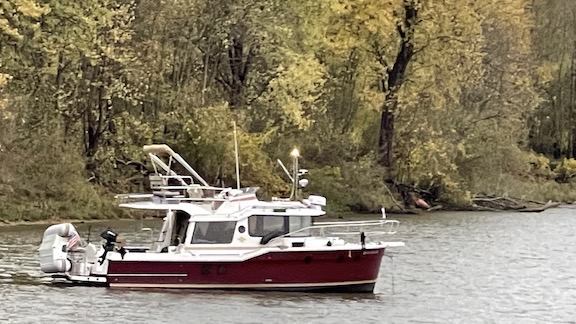
Connie on “La Principessa” shot this photo of “Do It Now” at anchor. This was the first and only time I’ve anchored out and I think I could have dropped the anchor a little farther from shore. I have an app on my phone (and my chartplotters) that can alert me if the anchor starts dragging, but I still slept like crap that night, worrying about the tail end of the boat drifting into the shore and not being able to power out. Yes, a stern anchor would help, but I don’t have one.
Scenery and Points of Interest
The scenery as you cruise varies greatly on the time of year and the waterway you’re on. The Puget Sound area, where I got my first experiences with the boat, offers outstanding views of forests and mountains, with all kinds of mammals and birds swimming in the water around you. The Chicago River is a crazy combination of buildings, bridges, and other water traffic. Farther south was industrial areas. The wide open spaces of trees and farms and small towns.
The views change gradually, given the slow speed. It reminds me a lot of how I experienced changes in terrain on long cross-country trips in my helicopter. Yes, I was moving along at 100 knots or more, but the grand landscape of the west changes gradually over many miles. This is the same, but with more subtle changes over fewer miles and longer stretches of time.
Most of the towns that have marinas or free places for a cruiser to park a boat overnight also have shops and restaurants. There are quaint downtown areas, many of which have historic buildings. There are always museums. Again, there are plenty of resources to help you find places of interest for a stop or an overnight stay. I have to admit that my trip between Chicago and the St. Louis area was a bit disappointing, mostly because we found ourselves in a bit of a hurry early and late in the trip, or dealing with cold weather, and I was sick with a cold in the middle. I feel as if I missed a lot of the exploring I might have done.
Weather
Weather is definitely a factor when you’re cruising in a small boat, although your tolerance to weather depends on your boat, your experience, the severity of the weather, and the way the weather affects the body of water you’re on.
In the two months I’ve been cruising on my own boat, I’ve been pretty lucky about weather. I had windy conditions in Puget Sound one day and relatively windy conditions on Lake Michigan another day, but neither experience was beyond what I or the boat could handle. Yes, we were tossed around and yes, water came up over the bow and had me using the windshield wipers on a day it wasn’t raining and yes, I wished that part of the trip was over and done while it was happening. But nothing broke, no one got sick, and the boat was never in any danger. Wind was also a factor during our first few days on the Illinois River, but again, it wasn’t a problem other than discomfort.
And of course, no one complains when the water is like glass or has tiny ripples that barely rock the boat.
I had one day of poor visibility on Puget Sound but it never got below a mile. I used the experience to experiment with my radar system — learning to read it so I could avoid obstacles if fog came up suddenly on a future cruise. Real fog delayed my departure from overnight parking on two occasions — who in their right mind would be in a hurry to leave a safe spot when they couldn’t see where they were going? (Contrary to popular belief, I am still in my right mind.)
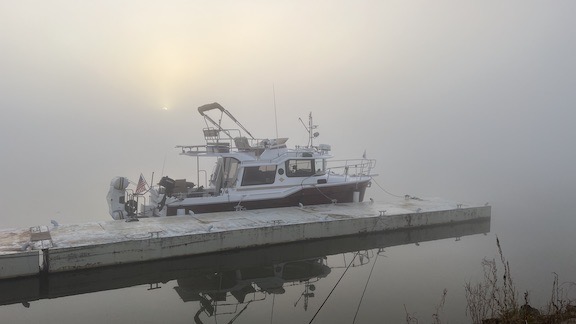
Fog delayed us only a short while at the $20 Mel’s Illinois River Restaurant dock in Hardin, where we stopped with “La Princepessa.” (Excellent, reasonably priced restaurant, by the way.) Our next stop was Grafton, only 20 miles away so it was a short day anyway.
We did allow weather forecasts to delay us a lot longer than we should have been delayed in Peoria, IL. The forecast called for high winds — which, other than somewhat rough water on the Illinois River, only really affected us in locks — followed by heavy rain. Rain forecasts went from less than an inch to up to two inches and then back down to less than an inch. We’d been warned about floating debris after regional rainfalls exceeding 1 inch. Another, larger boat was waiting it out and they seemed very concerned. That got my companion worried. It also got me concerned. What didn’t make things better is that I’d been dealing with a bad cold for a few days and was exhausted after even only a few hours at the helm. So I decided to wait, too.
Unfortunately, the “hazardous weather” turned out to be a big nothing burger. We wasted a total of 5 days in Peoria when 2 would have been enough. That basically closed the window for us to get much farther than St. Louis before it was time to go home. (The way I see it, 3 days wasted in Peoria plus 2 extra days spent in Grafton plus 2 extra days spent at Alton would have gotten us to Green Turtle Bay — a much better stopping spot to continue the trip in early December. Yes, logistics to get to St. Louis would have been tougher, but it would have been worth it to get what I see as the hardest part of the trip — Alton to Paducah — behind me.)
But this is all a learning experience. And I need to remember that sometimes the weather forecasts won’t overstate the hazards. Sometimes they’ll understate hazards and I could find myself in trouble. Better safe than sorry.
Size Matters
Of all the boats belonging to “Loopers” we met in October, my boat was the smallest. The second smallest was also a Ranger Tug, but it was the next size up — an R-31 rather than my R-29. All of the boats had two people on board.
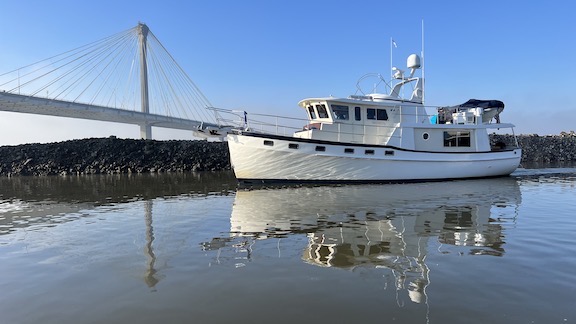
Nine Lives is a 48′ 2012 Kadey Krogen. Its owners, Kenny and Rhonda, live aboard year-round and just travel along the Great Loop. I took this photo as they left Alton Marina the other day.
According to Ranger Tugs, my boat is supposed to sleep six people. This number assumes two people in the main berth (which has an odd-shaped bed), two people in the lower berth (which has a full sized bed), and two people on the table converted to a bed (which I can’t do because the boat didn’t come with the required cushion). The reality is that unless two people really, really like each other, only one person is going to fit comfortably in each of the two berths. So I don’t think I’ll be encouraging any couples to accompany me.
Although there’s plenty of space on board for a traveler to get some alone time, the amount of comfortable space varies based on the weather. Sure, on a great day it’s wonderful to sit outside on the aft deck or up on the command bridge in the fresh air. But if it’s cold or rainy, inside is more pleasant. Then there are just three spaces (other than the head): the front cabin, the main cabin, and the lower cabin. The front and lower cabins are mostly beds. The main cabin has a nice sized table and two benches big enough to accommodate four people comfortably. That’s it.
The boat is also not designed for fat people. I’m not fat (in a rotund way), but I am overweight and I do need to shimmy through narrow spaces. They say I have a walk-around bed, but you can realize the absurdity of that statement when you try to walk around it. The door to the head is so narrow past the corner of my bed that it’s necessary to go through sideways. And I’ve stopped trying to get into the space between the helm and the back of the bench seat when the seat is facing the table. It’s almost wide enough.
Janet (who joined me on my October trip) and I called maneuvering around the boat, especially to get things out of the lower cabinets and refrigerator, “boat yoga.”
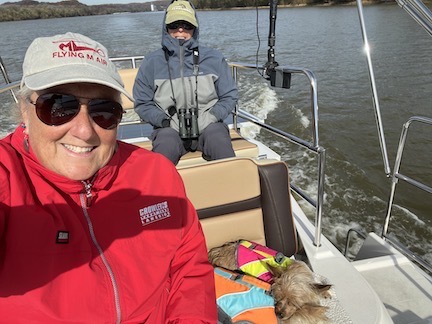
Here we are up on the command bridge while under way one morning. Do we look cold? We were! We went back inside the cabin not long after I made this selfie.
That said, the boat is very comfortable — at least to me. Remember, I’m coming to it from a slide-in truck camper. The boat is bigger. It has more windows and is brighter. It has a built-in inverter so I can use the microwave and coffee maker when I’m not plugged in. It has a generously sized aft deck with a table and seating for six — really! The command bridge seating is comfortable and a real joy when under way in warm weather. Yes, the bed is a weird shape, but it’s plenty big and I’m only sharing it with two tiny dogs.
Storage Cons and Pros
The front cabin has a clothes hanging rack that can accommodate about 10 hangers and, if they are used, the clothes block the use of some shelves and counter space there. There are a handful of other cabinets and a drawer that, if organized properly, can hold all my clothes. Or most of them. I use a large space under the bed to store off-season clothes; I have tank tops and shorts in there now. The trouble with that space is that you have to lift the mattress — which means unmaking the bed — to get into it. So it’s the kind of space where I’ll store things I can wait a week or two to retrieve — basically accessing it only when I change the sheets. The lower cabin has no storage other than a shelf along side the bed and one at the head of the bed. Whoever sleeps in there needs to stow their clothes in there or live out of a suitcase that can be taken out and placed on a table bench at bedtime.
Inside the main cabin is enough space to store dishes, silverware, utensils, pots, pans, and non-perishable foods — but not much else. The fridge is about the same size as my camper fridge, but the freezer is barely large enough to make and store ice and the door storage is very limited. There’s a compartment under the helm seat where I am storing tools and related items — including the extra remotes the boat came with for things like the auto pilot and search light. I’ve been storing manuals, log books, charts, and reference materials on the very large “dashboard” forward of the helm; that keeps them out of the way but easily accessible in transit.
There’s a ton of storage space under the aft deck — which is a blessing and a curse. A blessing because it offers space to keep relatively large things out of the way and dry but still relatively accessible. A curse because some of those things — like the generator — are heavy and they make the boat sit aft low in the water. This situation is not made any better by the fact that the dinghy, dinghy motor, and my electric bike are also in the back of the boat. There’s simply no place else to put any of these things. One of my projects when I get back to the boat later this month is to try to move things from under the aft deck to under the bed. There are a bunch of navigation reference guides in a box back there that will be the first to move.
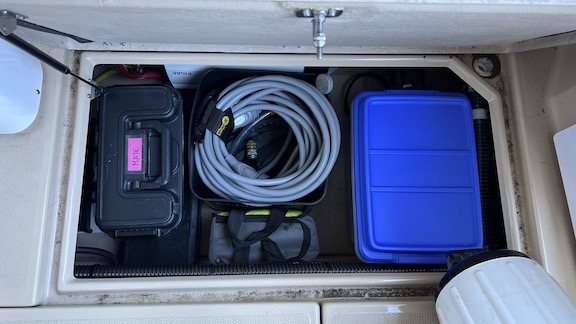
Here’s one of my aft deck storage areas. This one is on the starboard side. From left to right is a waterproof box with the charging cable and accessories for my electric bike with a very complete Harbor Freight toolbox beneath it, an open plastic bin containing my 30 amp power cable and a heavy duty hose, my battery operated drill in its case, and a latching bin containing another hose and various hose-related items. The engine and thruster batteries are under the deck to the left in this photo and the inverter/charger is under the deck at the top of this photo.
I should add here that I’ve acquired several latching plastic bins to store loose items on and under the aft deck and under passenger bench seat on the command bridge. Storing like items together is the key (in my opinion) to organization and the ability to find things. There are a lot of things that come with the boat and will eventually be used but are not used very often. An example of that is the canvas covers for outdoor seating, the command bridge helm, and various windows and doors on board. Two shallow bins with latching tops make these easy to store upstairs under that bench seat where they’re out of sight and out of mind. And taller bins specifically chosen for the way they fit under the aft deck can store hoses, power cables, spare parts, and other smaller items that would too easily get lost if left loose.
Marina Life
So far, most of our overnight stops have been at full-service marinas. Slips or dock spaces include 30 amp power and water spigots. The marina facilities usually include restrooms and showers which we try to make use of. Marinas also usually have fuel and pump-out service; I like the idea of topping off when I get below 2/3 tank if the next fuel stop is more than 50 miles away.
Using a marina restroom means making less deposits into the toilet’s holding tank so I can do pump-outs less frequently. Regular use of the toilet means pumping out once every two weeks for just me or once a week for me and a friend; using the marina restroom 50% of the time doubles the amount of time between pump outs.
As for showering, the boat has a decent little shower that I’ve used exactly once. The water is plenty hot and the water pressure is good. The space isn’t that small, either. But you I usually get a better shower in the marina’s facilities. (There was one recent exception to this when I had the worst shower I’d ever had anywhere — at a marina.)
The boat’s galley is complete with a refrigerator, microwave, sink, two-burner stove, and oven. (It actually has two refrigerators and a wine cooler, but I keep that second fridge turned off for now.) I also brought along a one-cup electric coffee maker, a small Instant Pot, and a stick blender. So I can make just about anything in the galley that I can make at home. Still, it’s nice to go out for a meal once in a while. The marina at Grafton had an excellent restaurant right on the premises and we ate there three times. I had my first oysters of the season and first crawfish in years.
Making and Learning from New Friends
A marina’s amenities are part of the reason I like staying at marinas. The other part is meeting and socializing with other boaters.
I hosted my first ever “docktails” with folks in a Ranger Tug named Pony that was parked next to us at DuSable Marina in Chicago; it was their first ever docktails, too. We traveled together from Chicago to Ottawa, IL. We met their friends in a 42 foot Grand Banks named La Principessa (the Princess) at Jolliet and played tag with them at marinas, docks, and anchorages in Henry, Peoria, Barstow, Hardin, Grafton, and Alton. We met the super experienced owners and full-time liveaboards in the 48 foot Kadey Krogen named Nine Lives, sharing lock space and marinas with them several times on the Illinois River. Then there was the weather worried folks aboard the 40 foot Kha Shing Vista named Balclutha Too; I just discovered today that they lost one engine 100 miles north of Grafton — in an area with virtually no services — and managed to get to Portage du Sioux (between Alton and Grafton) for repairs. (If the timing is right, I might resume the trip with them at month end; it depends on how long their repairs take.) We also met sailors who were motoring with their masts stepped down in Black Majik and Yuca. I can track all of these people on the Nebo app and message them in the app or via text. It’s great to get news about conditions and facilities ahead of me on my trip from others as they pass through.
Most of these boaters have far more experience than I do and are willing to share what they know to make my journey easier. It’s a real pleasure to have them point out things I could do better or differently. I’m trying to be a sponge that soaks up experiences and information. These folks have been invaluable to me as sources of information and moral support. They’re one of the best things so far about my cruising life.
40-Day Opinion?
So far, I have to give my cruising life a two thumbs up. It’s not all sunshine and glassy smooth water, but it is the comfortable, doable, rewarding challenge that I hoped it would be.
I’m home now for three weeks to sell some jewelry at two shows, prep my house for its winter occupant, and touch base with local friends. I’ve already got my plane ticket back to the boat. Frankly, I’m counting the days until I can get back to it.


